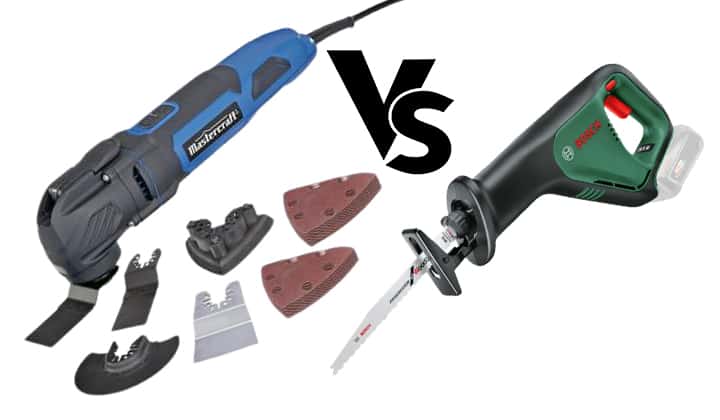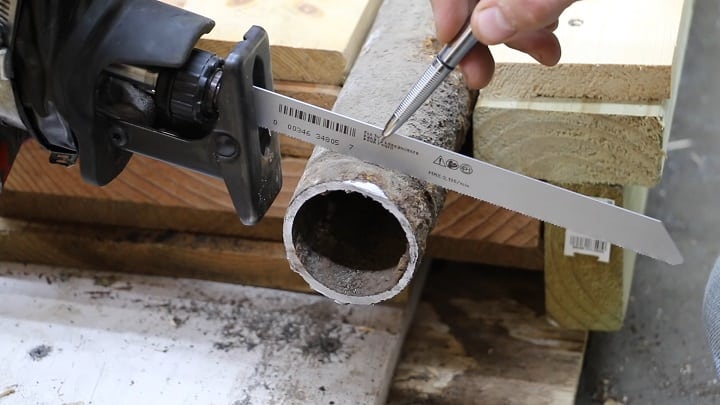I love creating free content full of tips for my readers, you. I don't accept paid sponsorships, my opinion is my own, but if you find my recommendations helpful and you end up buying something you like through one of my links, I could earn a commission at no extra cost to you. Learn more
Two of the most commonly used tools in handyman and construction work are oscillating multi-purpose tools and reciprocating saws. An oscillating tool is the best option for small space, and a reciprocating saw for demolition work.

In this post we'll cover:
What Is an Oscillating Tool?
The term oscillating stands for swinging back & forth in a rhythmic manner. So, in general terms, oscillating stands for swinging from one side to the other. This is exactly what an Oscillating tool does. An oscillating tool is a multi-purpose professional-grade construction tool that uses oscillating motion to cut through objects & materials. But that’s not all, as mentioned, the oscillating tool is considered to be a multi-purpose tool, meaning it is not only used for cutting but also sanding, polishing, grinding, sawing, and much more handyman-related work. An oscillating tool is small in size and comes with a small blade factor with tiny yet sharp teeth. There are quite many blade types for you to choose from, and not all of them have teeth. As it is a multi-purpose tool, changing the blade type will change the type of work that you can do with the tool. For this versatility, oscillating tools are involved in almost every type of handyman & construction-related works.How an Oscillating Tool Works?
The working process of an oscillating tool is quite similar to any other power tool that we encounter in our day-to-day lives. There are generally two types of oscillating tools: corded oscillating tool and cordless oscillating tool. There are also other variations of oscillating tools, but that’s a topic for another time. Turning on the power switch will make the tool come to life, and you can get started on working with it. As mentioned before, oscillating tools use oscillating motion for work. So, once you turn it on, the blade will start to swing back and forth. Now, if you are planning on cutting with your oscillating tool, then simply press the tool on the surface and slowly work through the surface of the object you will be cutting through. This method is also applicable for sanding, polishing, sawing, and other usages of the tool.What Is a Reciprocating Saw?
Reciprocating is also a part of the four types of prime motion. Oscillating is also a part of it. The term reciprocating stands for push & pull rhythmic motion. Therefore, a reciprocating saw is a powerful tool that utilizes the reciprocating motion and cuts through almost all types of materials and objects that people come across during construction or demolition work. Reciprocating saws are considered to be one of the most powerful cutting & sawing tools. The blade of a reciprocating saw uses the push-pull or up-down method to cut anything you throw at it. Make sure you use the right blade capable of cutting the material you will work on. Therefore, the performance of a reciprocating saw highly depends on the blade. You will find different types of blades for sawing & cutting different types of materials. Not only that, but the length and the weight of the blade also come into play when you plan on cutting something with a reciprocating blade. The outlook of a reciprocating saw is like a rifle. It is robust and quite heavy compared to other saws that you might find in your local hardware store. The corded reciprocating saws are heavier compared to their cordless versions.How a Reciprocating Saw Works
As mentioned before, a reciprocating blade utilizes push & pull or up-down method for cutting or sawing through an object. And similar to most power tools on the market, a reciprocating saw generally has two versions: a corded one and a cordless one.
The Difference Between an Oscillating Tool & a Reciprocating Saw
Now there is a lot of difference that you can find between an oscillating tool and a reciprocating saw. These differences make them stand out from each other. The most common differences that you will find between an oscillating tool and a reciprocating saw are –The Motion of Each Tool
As their name suggests, oscillating tools use oscillation motion or back & forth swinging motion, while reciprocating devices use push & pull or reciprocating motion. Although, many think this is a minor difference, the core of each device lies on this matter. Because due to their unique motion, the cutting method is completely different. This affects not only the balance but also the efficiency of the tools. For example, if you plan on doing deep cuts into an object, then going with a reciprocating motion for your cutting sessions is the best option. But if you want a more accurate option, then swinging motion or oscillating motion is the best. The motion also has a huge impact on the speed.Stoke Length & Speed
The number of strokes that a tool can make during the cutting process determines how efficient the tool is. In general terms, the stroke length of an oscillating tool is quite low compared to a reciprocating saw. But on the other hand, an oscillating tool has a higher stroke speed than a reciprocating saw. A standard oscillating tool has a stroke speed of 20,000 strokes per minute. At the same time, an industry-level reciprocating saw has a stroke speed of 9,000 to 10,000 stroker per minute. So, there is no better option than an oscillating tool for cleaner cuts at a faster rate.Blade Configuration of the Tools
The blade configuration of an oscillating saw is quite interesting, to say the least. Most oscillation tools are either square or rectangular shaped, but a few have a semi-circle shape on them. The blade’s teeth are found on the end & the sides of the blade. For the semi-circular option, the teeth are one-sided. Now, as we all know that different types of blades on an oscillating blade have different purposes, there are oscillating blades that don’t have any teeth. A good example of these types of blades will be the blades used for sanding surfaces with an oscillating tool. The blades used for polishing also have the same features. On the other hand, the blade configuration for reciprocating blades is always the same. A reciprocating blade has its teeth on one side only. They look like ultra-thin serrated knives. The blades can be flexed if there is a change in the angle of the cut. As reciprocating saw uses up and down motion, when you insert a blade on the saw the teeth, will be facing up or down depending on how you inserted the blade on the saw.Quality & Lifespan
As reciprocating saws are sturdier and robust compared to oscillating tools, reciprocating saws have a greater lifespan than oscillating tools. The quality of the corded version remains the same during their lifespan. But the quality of the cordless version of both tools has dropped over the years. With proper care, a reciprocating saw will last from 10 to 15 years, where an oscillating tool will last for 5 years with intensive care.Versatility
This is where oscillating tools dominate over reciprocating saws. Reciprocating saws are used for one purpose only, and that is to saw or cut through objects. But oscillating tools can be used in various scenarios. From cutting to polishing and even sanding, oscillating tools have dominance over almost every area of handyman and small construction works.Size & Weight
Oscillating tools are small in size compared to reciprocating saws, they are made for mobility. For that reason, the size and the weight of an oscillating are very low. On the other hand, the reciprocating saw is bigger in size and is one of the most weighted tools that you will encounter in your life. The main reason for this is the weight of the motor along with the blade and metal body of the saw.Durability
This is no brainer that a reciprocating saw will be more durable than an oscillation tool. Because while the weight and larger size can be difficult to carry and balance, it also gives the tools more durability and strength. That’s why when it comes to durability, reciprocating saw wins over oscillating tools every time.Accuracy
This is one of the key factors for tools like the oscillating saw and reciprocating saw. An oscillating tool is superior when it comes to accuracy when compared to a reciprocating saw. That’s because the size of an oscillating tool isn’t too big for you to control, and it doesn’t deliver too much raw power. Therefore, it is quite easy to handle and balance. On the other hand, the main purpose for a reciprocating saw was for demolition. So, a reciprocating saw is also known as a wrecker saw among professionals. Its accuracy and precision aren’t the best. It is very hard to control, and you will need to use your entire body just to balance a reciprocating saw. But if you apply the proper techniques, then you can make precise cuts even with a reciprocating saw.Oscillating Tool vs Reciprocating Saw: Who’s the Winner?
Both of the tools are great at what they do. It depends on which type of work you need to get done with the tools. If you are working on a small object or want to make precise cuts easily, then the oscillating tool is the clear winner. But if you want power and want to cut stronger & larger objects, then there are no options better than a reciprocating saw. So, in the end, it all comes down to what type of projects you mostly deal with.Conclusion
Both oscillating tools & reciprocating saws are great at what they do. Therefore, there is no clear winner when it comes to oscillating tool vs reciprocating saw. It highly depends on the scenario. And if you have come this far in the article, then you already know in which situations the tools perform the best. So, use that knowledge to pick the best tool to do your work easily. Best of luck!I'm Joost Nusselder, the founder of Tools Doctor, content marketer, and dad. I love trying out new equipment, and together with my team I've been creating in-depth blog articles since 2016 to help loyal readers with tools & crafting tips.
